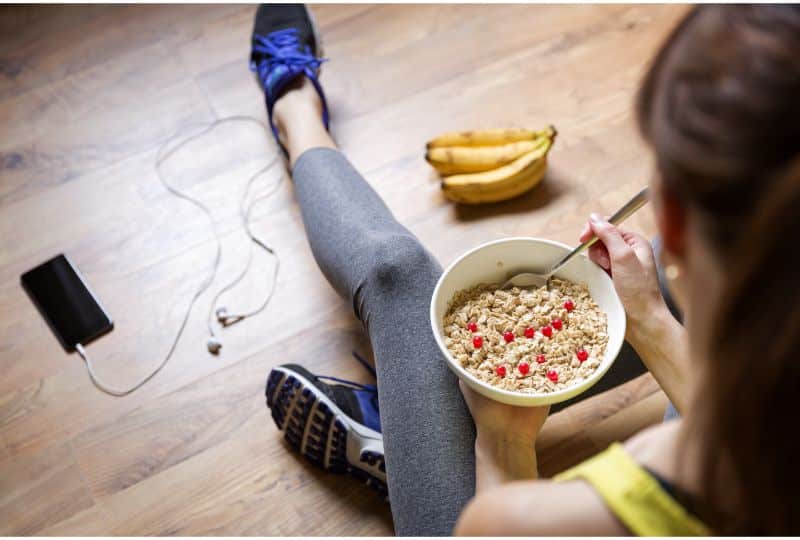Does Jogging Build Muscle
This page contains affiliate links. As an Amazon Associate I earn from qualifying purchases.
Although most people associate building muscle with weights and strength training, many of us have had a few thoughts about whether jogging builds muscle. Well, the simple answer is yes! With the appropriate nutrition plan and proper training, you can build strong, healthy muscles by jogging. This is ideal for long, lean muscles instead of bulky ones.
Building muscle has many health benefits, from increasing your metabolism and managing chronic health conditions to strengthening your bones and joints. So if you are ready to get jogging to build muscle, keep reading to find out everything you need to know about it.
Quick Navigation
How Do Our Bodies Build Muscle?
This process is relatively simple and boils down to a straightforward equation: stress + recovery = adaptation. Whenever we force our body to work harder than it is used to, we place it under stress. This can be through lifting weights, boxing, doing bodyweight exercises, or jogging, to name a few activities.
Pushing your body to do these stress activities breaks down the tissues in your existing muscles, which prompts the recovery process, which rebuilds the muscles back to be stronger than they were before.
If you skip the recovery process, your muscle will not be able to perform properly when you jog, and you may be left feeling stiff and sore. Recovery can include staying off your feet and giving your body a complete break, but it can also include lower impact workouts like swimming, walking, and light jogging.
When you give your body these recovery sessions, they will adapt to the stress you place your muscles under, becoming stronger, thus developing your muscles.
Does Jogging Build Good Muscle?
Jogging (and running) is a great way to build strong, healthy muscle as the repeated impact on the ground is a form of stress on your body. Jogging primarily works the muscles in your lower body, including your lower back, hips, glutes, legs, and feet.
Your glutes and calves are the powerhouses that push your body’s force into the ground. Running engages your hamstrings and hip flexors, especially when you increase your pace or strides per minute.
Different muscle fibers are worked by the various types of jogging and running. The two skeletal muscle fibers in the human body are fast-twitch and slow-twitch muscle fibers.
Fast-twitch fibers support the movements of a faster, more powerful force. These muscles are built doing hill runs and sprints and are great to improve speed, but they fatigue quite quickly.
Slow-twitch fibers support long, continuous activities, like longer-distance runs. They do not fatigue easily and allow you to work on endurance.
How to Build Your Muscles by Jogging
Because running and jogging are so repetitive, the potential to build muscle is relatively limited if you don’t have a varied training plan. To keep your muscles getting stronger, you must keep challenging yourself.
In some scenarios, if you always run the same distance at the same pace and stay in the same heart rate zone, you can actually lose muscle.
To become stronger by running, you need to incorporate different types, lengths, and intensities of runs, where each works varying muscle fibers. Distance runners, for example, can integrate high resistance training and sprints into their routine once or twice a week, whereas sprinters can benefit from a 5 – 8 mile run each week.

Different Running to Build Muscle
Here are examples of different types of running you can do to build muscle.
High Resistance Interval Training (HIIT)
This type of run involves using weights (like ankle or wrist weights, or a weighted pack) or an incline. Run with this resistance for 5 – 12 seconds, followed by 60 seconds of walking. Repeat this set 10 – 20 times. When in the intense part of the set, work at around 80% of your maximum heart rate, and when in the recovery part of the set, work at about 50% of your maximum heart rate.
High-Intensity Continuous Training (HICT)
For this type of running, jog slowly at a constant pace for 5 – 20 minutes with high resistance.
Sprint Intervals
Sprint as fast as you can with no resistance for 15 – 30 seconds, then walk or jog slowly for 1 – 2 minutes. Repeat this set 10 times.
Longer Distance Runs
These types of runs are great for building slow-twitch muscle fibers. Do a long run at a consistent pace for 60 – 120 minutes.
Recovery Jogs
Walk or jog slowly for 30 – 45 minutes. This is a vital component to your training program to build muscle as recovery jogs allow your muscles to repair.
While everyone’s training schedule will look different based on their skills and goals, it is vital to ensure you push yourself when doing higher intensity runs, but mix up your runs and include at least one or two recovery runs every week.
Additionally, you may want to incorporate some lighter weight sessions to increase your muscle mass in the supporting muscles.
Optimal Diet to Build Muscle
It is not enough to just do your different runs and jogs. Nutrition is a vital component to building healthy muscles and allowing you to do your workouts effectively. Jogging and running, especially when you do your longer-distance jogs, burn many calories, so eating the right amount and quality of food to build muscle and fuel your body is critical.
Eating healthy carbs like sweet potatoes, quinoa, oats, and brown rice before you run can ensure you have plenty of energy to sustain your body.
Protein-rich foods like eggs, fish, poultry, chickpeas, and tofu are excellent foods to eat after your runs and workouts. They work to rebuild the muscle fibers that have been broken down during your activity. It is best to eat these foods in the first 15 minutes after your workout to replenish the calories you have burned.
To gain muscle, sports nutritionists recommend consuming 0.5 – 0.8 grams of protein for every pound you weigh. This means a 150-pound runner should eat 75 – 120 grams of protein every day.
Final Thoughts
Because running is very repetitive, you must challenge yourself and create variety in your runs to allow your body to keep becoming stronger. Include some interval runs (both sprints and high resistance) along with your regular jogs, get plenty of rest, stay hydrated, and follow a balanced, nutritious diet and you will see excellent results.



